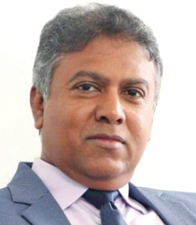With the recent development of a new tariff brought forward by the Government, the Sunday Observer interviewed one of the industry leaders in the solar energy sector, Dr. Lakmal Fernando. In his view, this goes against the mandate for promoting solar (and renewable) energy.

Dr. Lakmal Fernando
The renewable energy sector has been the livewire of the energy sector over the past many years, adding almost 1,500 MW of capacity to the national grid. This has resulted in reducing the consumer tariffs and stabilising it to the current lower levels purely because the feed-in tariffs were in rupee terms. With the rupee value diminishing from the 130 to 300 range against the US dollar, all other fossil fuel based energy sources have reached double the price while renewable energy has remained constant.
As per the Cabinet Memorandum dated March 18 on revision of tariffs for renewable energy, “Only the fixed return on equity of 11.47 percent (the Government bond rate published in January 2025) is offered for Rooftop Solar projects, with zero risk premiums.
Dr. Fernando questions whether anyone would invest in rooftop solar systems with this kind of negative financial return. This will curtail the solar PV integration to the national grid and the end result can be detrimental to the country.
He said that if this tariff revision is established, there could be enormous risks for the country’s economy due to the heavier dependency on fossil fuel based energy and our inability to meet the international commitments.
He said that for us Sri Lankans, investing in risk-free options like Government Treasury bonds would become far more secure than going for solar systems, which come with higher risks like frequent power outages and plant breakdowns which discourage prudent investments of the prosumers.
He said that Sri Lanka once prioritised renewable energy with almost 100 percent electrical energy generated on demand by renewable sources. However, as energy demand surged with the country’s push for 100 percent electrification, the reliance on fossil fuels increased.
“Due to these energy demands, developing countries like ours had no option during that time but to turn to unsustainable energy sources like coal, diesel, and other heavy fuels. Later in 2016, with the introduction of ‘Soorya Bala Sangramaya’ (Battle for Solar Power) scheme, the Government introduced two new schemes called Net Accounting and Net Plus. Until 2016, the rooftop solar integration was with the net metering scheme only.
Later, another Solar Photo-Voltaic (PV) grid connection mechanism was introduced named “Net Plus” enabling large volumes of Solar Energy to be added to the grid. These policies spurred economic growth, creating jobs and new investment opportunities in the solar industry.
These developments have been a major success, with over 1,600 Megawatt of the total installed capacity in the country, produced by renewable energy sources such as rooftop solar.
Out of these 1,600MW, he said that rooftop solar alone accounts for 1,450MW. Dr. Fernando mentioned that using rooftops is far more beneficial than any other Renewable Energy source as it has zero environmental impact, utilises zero land and has very marginal or no transmission losses. The rooftop solar industry has only created a positive impact on the economy and given benefits to the entire population of 22.5 million in the country.
Prosumers
He said that for a country like ours, having rooftops capable of distributing energy to nearby areas is very beneficial. Rooftop solar panels eliminate transmission losses, unlike large coal power plants that supply electricity over vast distances which require massive –pylons. He said that even though these percentage numbers might be low, all the benefits of these savings would directly go to the population at large.
He also said that rooftop solar systems have contributed to creating a robust micro-economy in the country during the past decade. Over 100,000 people have connected their solar rooftops to the grid, making them “prosumers” and millions of others are waiting to join in.
However, any drastic tariff reduction will only de-motivate the prosumers to give up their decision to have green energy on their roofs. This micro-economy is valued at over Rs. 200 billion and is mainly funded by local banks, thus creating a positive impact on the banking sector as well. The lives of these prosumers have been uplifted, with a positive impact on the rural economy.
The rooftop solar energy sector in the country has paved the way to create over 750 entrepreneurs, and over 50,000 jobs. Most of these companies are Small and Medium Scale Enterprises (SMEs) that are working as a team towards the development of green energy in Sri Lanka. However, with the recent developments in proposed tariff reductions for rooftop solar, which is the main target of small-scale solar companies, the jobs of at least half of these workers are at risk.
Future goals
In addition, he said that according to the terms of the Paris Climate Accord, Sri Lanka has to turn 70 percent of its energy sources to renewable energy by 2030. Out of all the renewable energy sources available to us, he mentions that solar energy is the most sustainable, abundant and financially viable resource, even more than wind energy.
He said that the issues regarding solar are almost zero, while rooftop solar is already a mature and well established technology all over the world. Moreover, the cost of solar panels is plummeting year after year, while their efficiency is going up with the use of new solar and inverter technologies.
He says that moving forward with this tariff scheme has been suggested because the utility claims that the overall system cannot handle the scattered small-scale power plants. However, with the numbers given earlier and the amount of energy that the current rooftop solar systems provide, Dr. Fernando said there is a shortage of about 1,200MW as of date.
No one speaks about reducing the cost of Fossil Fuel based energy which is generally over Rs.75 per comparative unit. He expressed concerns that this decision may contribute to future energy shortages and economic downfall. With Sri Lanka poised to phase out the use of fossil fuels in the face of the looming 2050 Net Zero deadline, now is the time to give more prominence to solar.









